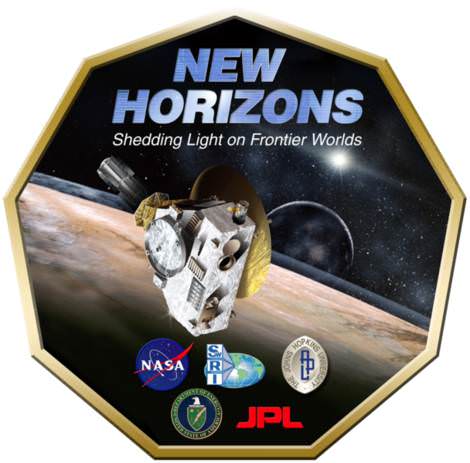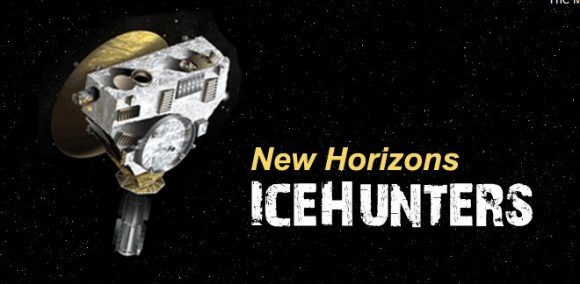How would you like to help choose an additional destination or two for a spacecraft heading to the outer solar system? A new citizen science project from the Zooniverse — called Ice Hunters — will allow the public to help discover a potential new, icy follow-on destination for NASA’s New Horizons spacecraft, which is currently en route to make the first flyby of the Pluto system. However, after it zooms past Pluto, the spacecraft will have the capability to explore other Kuiper Belt Objects. But, the destination has yet to be chosen. That’s where you can help.
“Projects like this make the public part of modern space exploration,” said Dr. Pamela Gay. “The New Horizon’s mission was launched knowing we’d have to discover the object it would visit after Pluto. Now is the time to make that discovery and thanks to IceHunters, anyone can be that discoverer.”
With Ice Hunters, the public can help scientists search through specially-obtained deep telescopic images for currently unknown objects in the Kuiper Belt. While the images you’ll be perusing in Ice Hunters won’t be the beautiful astronomical images seen in the Galaxy Zoo classification of galaxies or the Moon Zoo images of the Moon, the science rewards in Ice Hunters will be spectacular.
And there’s more: there’s also the potential for discovering variable stars and asteroids.
What’s cool is that you’ll be searching for KBO’s and potential dwarf planets in much the same way that Clyde Tombaugh found Pluto: comparing images of the same region of the Kuiper Belt and looking for objects that move or vary in brightness.
“The New Horizons project is breaking new ground in many ways,” said New Horizons Principal Investigator Alan Stern. “We’re flying by a new kind of planet and we’ll be making the most distant encounters with planetary bodies in the history of space exploration, and now we’re employing citizen science to help find our potential extended mission flyby targets, perhaps a billion kilometers farther than even distant Pluto and its moons. We’re very excited to be working with Zooniverse and breaking this new kind of ground. We hope the public will be excited to join in with us and with Zooniverse to make a little history of their own by discovering our next flyby target after Pluto.”
Somewhere, on the outer edges of the solar system an icy body lurks undiscovered, orbiting on a path that will just happen to carry it toward a potential rendezvous with the New Horizons spacecraft.
New Horizons will flyby Pluto in 2015, and there will be enough gas in the spacecraft’s tank to fly toward at least one and possibly two Kuiper Belt Objects in the distant outer solar system. The expected date of the KBO flyby will be between 2016 and 2020, depending on the object chosen and its distance from Pluto.
Your mission, should you choose to accept, is to find the most interesting KBO possible for New Horizons to visit. If that object can be found , it will become the most distant object ever visited by a spacecraft from Earth.
The Kuiper Belt is a region of the outer solar system, extending past Neptune, (from 30AU) out to nearly twice Neptune’s orbit (out to roughly 55AU), which contains icy bodies in a variety of different sizes up to thousands of kilometers across. The first KBO other than Pluto was only discovered in 1992, and the KBO population is still not well mapped. Ice Hunters will do its part to study one small slice of the Kuiper Belt as it looks for an object along New Horizon’s trajectory after its Pluto flyby.
Using some of the largest telescopes in the world, scientists have imaged that region, producing millions of pictures for that could contain images of the rare objects that are orbiting toward just the right location, along with many other small worlds on different trajectories.
In “difference” images, which are created by subtracting observations taken at two different times, scientists can mostly (but not entirely) remove the light from constant sources like stars and galaxies. Left behind are the things that move or vary in brightness, which is what the users of IceHunters will be looking for. Since the stars never subtract off perfectly, the images appear messy, and computers can’t be trained to find objects as effectively as people can.
“When you’re looking for something special in masses of messy, real-world data, sometimes there’s no substitute for the human eye, and Zooniverse Ice Hunters will put thousands of eyes to work on this important job,” said John Spencer of Southwest Research Institute, a member of the New Horizons science team who is coordinating the search effort.
Just as other Zooniverse projects have easy-to-use websites, IceHunters.org is no different. “Using just about any modern web-browser, users can circle potential KBOs and mark with a star the locations of asteroids,” said web developer Cory Lehan from Southern Illinois University Edwardsville, who has participated in several Zooniverse web designs. “The website is filled with examples to help get people started. Anyone should be able to take part – No Flash required.”
So check out Ice Hunters and start discovering today!
You can follow Universe Today senior editor Nancy Atkinson on Twitter: @Nancy_A. Follow Universe Today for the latest space and astronomy news on Twitter @universetoday and on Facebook.



I have already checked out around 6000 images and found around 3000 objects. I was testing it. It’s addictive. :]
Paragraph nine: “if you chose to accept” might be better as choose.
and in paragraph twelve: “a people” is an odd expression. Nitpicking is us.
Agreed on both counts. Also, it appears that I’ve got nearly everybody here into the habit of nitpicking!